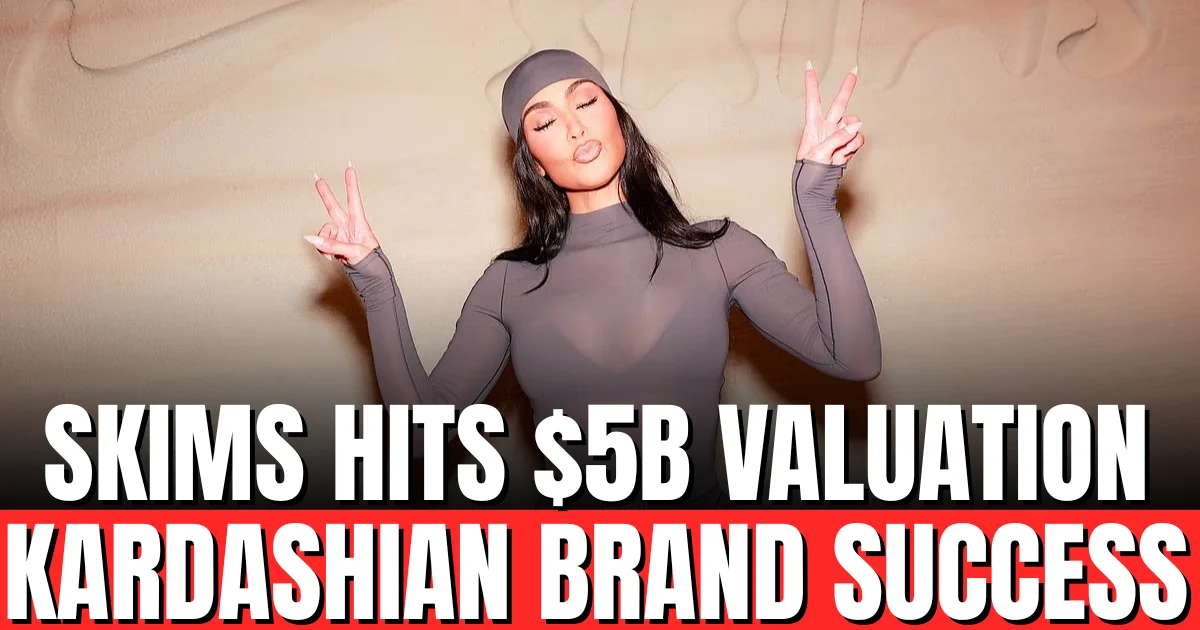Kim Kardashian’s Skims reaches $5 billion valuation in latest funding. Business strategy, growth factors, competition analysis, future prospects. Details!
Table of Contents
Kim Kardashian’s Skims Brand Achieves $5 Billion Valuation in Latest Funding Round
Shapewear Company’s Meteoric Rise Reflects Celebrity Entrepreneur Success and Growing Intimates Market
Kim Kardashian’s shapewear and loungewear brand Skims has reached a $5 billion valuation following its latest funding round, cementing the company’s position as one of the most successful celebrity-founded fashion businesses in history. The valuation represents a dramatic increase from the company’s $3.2 billion assessment just 18 months ago, demonstrating robust growth in the competitive intimates and athleisure market.
The funding round, led by existing investors including Imaginary Ventures and Andreessen Horowitz, injected approximately $270 million into the company while validating Skims’ business model of combining celebrity influence, inclusive sizing, innovative marketing, and direct-to-consumer retail strategy. The valuation places Skims among fashion industry unicorns and establishes Kardashian as a formidable force in business beyond her entertainment career.
“Skims has transformed the intimates industry through inclusive design, innovative fabrics, and authentic connection with customers,” said Jens Grede, Skims co-founder and CEO. “This valuation reflects not just our current success but confidence in our vision for building a multi-generational brand that redefines how women experience comfort and confidence.”
The achievement represents the convergence of celebrity entrepreneurship, social media marketing, and e-commerce evolution, demonstrating how influencer-founded brands can achieve traditional fashion house valuations while maintaining modern, digital-first business models that resonate with contemporary consumers.
Understanding Skims’ Success
Company Overview
Founded: 2019
Founders: Kim Kardashian, Jens Grede, Emma Grede
Headquarters: Los Angeles, California
Products: Shapewear, loungewear, underwear, sleepwear, swimwear
Distribution: Direct-to-consumer (website), select retail partnerships
Employees: Approximately 200+
Revenue Estimates:
- 2023 projected revenue: $750 million – $1 billion
- 2022 revenue: Approximately $500-600 million
- Year-over-year growth: 40-50% consistently
Market Position:
- Leading shapewear brand by sales volume
- Top 5 in intimates category
- Dominant in social media engagement
Product Innovation
What Differentiates Skims:
Inclusive Sizing:
- Size XXS through 4XL (9 sizes initially, expanded to 9+ sizes)
- Shade range: 9 tones for body-matching products
- Fit technology for diverse body types
Fabric Technology:
- Proprietary compression materials
- Seamless construction
- Temperature-regulating fabrics
- Comfortable all-day wear
Design Philosophy:
- Solutions-oriented (addresses specific needs)
- Minimalist aesthetic
- Versatile basics
- Trend-responsive collections
Price Positioning:
- Mid-range: 18−18−98 typically
- Lower than luxury (Wolford, Commando)
- Higher than mass market (Spanx basic line)
- Value perception strong
Business Strategy Behind the Valuation
Direct-to-Consumer Model
E-Commerce Focus:
- Primary sales through Skims.com
- Controlled customer experience
- Higher margins than wholesale
- Data collection for product development
Strategic Retail Partnerships:
- Nordstrom (launched 2021)
- Selfridges (UK)
- Limited international partners
- Maintains scarcity while expanding access
Advantages:
- 60-70% gross margins (vs. 40-50% wholesale)
- Customer data ownership
- Rapid product iteration
- Brand control
Marketing and Brand Building
Social Media Dominance:
Kim Kardashian’s Influence:
- 364 million Instagram followers
- Personal product endorsement
- Behind-the-scenes content
- Authentic engagement
Paid Marketing:
- Sophisticated digital advertising
- Influencer partnerships (beyond Kim)
- Celebrity collaborations
- Performance marketing optimization
Campaign Strategy:
- Inclusive casting (diverse bodies, ages, backgrounds)
- Real customer testimonials
- Viral moments (Met Gala appearances)
- Cultural relevance
Product Development Cycle
Fast Fashion Principles:
- Rapid trend response
- Customer feedback integration
- Weekly new releases
- Limited edition drops
Category Expansion:
- Launched shapewear (2019)
- Added loungewear (2020)
- Introduced swim (2022)
- Expanded to men’s line (2023)
Innovation Pipeline:
Continuous fabric development, fit improvements, new categories testing.
The Funding Round Details
Investment Structure
Lead Investors:
- Imaginary Ventures (fashion/lifestyle focus)
- Andreessen Horowitz (a16z – tech VC powerhouse)
- Additional institutional investors
Previous Funding:
- 2021: 1.6billionvaluation(1.6billionvaluation(154M raise)
- 2023: 3.2billionvaluation(3.2billionvaluation(240M raise)
- 2025: **5billionvaluation∗∗(5billionvaluation∗∗(270M raise)
Use of Funds:
- International expansion
- Technology infrastructure
- Supply chain optimization
- Retail partnerships
- Marketing and brand building
Why Investors Are Bullish
Growth Metrics:
- Consistent 40-50% annual revenue growth
- Strong unit economics
- Repeat customer rate exceeding 40%
- Expanding average order value
Market Opportunity:
- Global shapewear market: $3.5 billion (growing 6-8% annually)
- Broader intimates market: $60+ billion
- Loungewear category expansion
- International white space
Competitive Advantages:
- Kardashian brand power
- Proprietary fit and fabric technology
- Direct customer relationships
- Cultural momentum
Market Context and Competition
Shapewear Industry Landscape
Traditional Players:
Spanx:
- Founded 2000 by Sara Blakely
- Market leader for two decades
- Estimated valuation: $1.2 billion (2021 Blackstone acquisition)
- Traditional retail distribution
Comparison:
Skims surpassed Spanx in brand value through:
- Digital-first approach
- Inclusive marketing
- Broader product range
- Celebrity founder advantage
Other Competitors:
- Commando (premium positioning)
- Yitty (Lizzo’s brand – body positivity focus)
- Honeylove (digital-native competitor)
- Traditional brands (Maidenform, Wacoal)
Broader Fashion Industry Trends
Celebrity Brand Success:
- Fenty (Rihanna – beauty $2.8B valuation)
- Savage X Fenty (lingerie unicorn)
- Ivy Park (Beyoncé – Adidas partnership)
Common Success Factors:
- Authentic founder involvement
- Social media mastery
- Inclusive positioning
- Direct-to-consumer focus
Kim Kardashian’s Business Empire
Beyond Skims
Total Estimated Net Worth: $1.7 billion (Forbes, 2024)
Primary Holdings:
Skims:
- Owns approximately 35% stake
- Current value: ~$1.75 billion
Other Ventures:
- KKW Beauty (fragrance – relaunched as SKKN)
- SKKN by Kim (skincare – launched 2022)
- Private equity investments
- Real estate portfolio
Entertainment Income:
- Reality TV (The Kardashians – Hulu)
- Social media partnerships
- Licensing deals
Business Acumen Recognition
From Reality Star to Business Mogul:
Strategic Evolution:
- Leveraged fame into business ventures
- Partnered with experienced operators
- Data-driven decision making
- Continuous brand evolution
Industry Respect:
Despite initial skepticism, Kardashian has earned recognition from:
- Business publications (Forbes, Fast Company)
- Fashion industry (CFDA recognition)
- Venture capital community
Challenges and Risks
Potential Obstacles
Market Saturation:
- Shapewear market becoming crowded
- Competition intensifying
- Differentiation harder to maintain
Celebrity Dependency:
- Brand heavily tied to Kim Kardashian
- Reputation risks affect company
- Succession/legacy planning needed
Retail Evolution:
- Direct-to-consumer costs rising
- Customer acquisition expensive
- Amazon/marketplace pressure
International Expansion:
- Cultural adaptation required
- Logistics complexity
- Regulatory compliance varied
Growth Sustainability Questions
Can Skims Maintain 40-50% Growth?
- Market size limitations
- Competition increasing
- Law of large numbers
Path to Profitability:
Current focus on growth over profit, but investors expect:
- Clear path to profitability
- Unit economics that scale
- Sustainable competitive advantages
What’s Next for Skims
Growth Strategy
Geographic Expansion:
- Europe (UK, France, Germany)
- Asia (Japan, South Korea, China)
- Localized product development
Category Extensions:
- Men’s expansion
- Athletic performance wear
- Maternity line consideration
- Plus-size specific designs
Retail Presence:
- Flagship stores (first opened NYC 2024)
- Pop-up experiences
- Expanded wholesale partnerships
- International department stores
Long-Term Vision
IPO Speculation:
- Valuation growth positions company for public markets
- Timeline: 2026-2027 estimated
- Comparable to Warby Parker, Allbirds trajectories
Multi-Generational Brand:
- Reducing celebrity founder dependency
- Building enduring brand equity
- Expanding beyond core customer base
Frequently Asked Questions (FAQs)
How did Skims reach a $5 billion valuation?
Skims achieved its $5 billion valuation through consistent 40-50% annual revenue growth (reaching estimated 750M−750M−1B in 2023), strong unit economics from direct-to-consumer sales, successful product innovation across shapewear and loungewear categories, and Kim Kardashian’s massive marketing influence. Investors value the company’s market leadership, repeat customer rates exceeding 40%, profitable expansion into new categories, and significant international growth potential in the $60+ billion global intimates market.
Is Skims profitable or just growing revenue?
Skims has not publicly disclosed profitability metrics, but industry analysis suggests the company prioritizes growth over current profits—typical for venture-backed consumer brands. Direct-to-consumer gross margins of 60-70% are healthy, but marketing and operational costs likely mean the company operates near break-even or modest losses while investing in expansion. Investors appear confident in future profitability given strong unit economics and the brand’s ability to scale efficiently once growth moderates.
How does Skims compare to Spanx?
Skims has surpassed Spanx in brand valuation ($5 billion vs. Spanx’s $1.2 billion Blackstone acquisition value) and cultural relevance despite Spanx’s longer history and market leadership for two decades. Skims differentiated through digital-first distribution, inclusive sizing and marketing, broader product categories, and Kim Kardashian’s social media influence. Spanx focused on traditional retail and problem-solving shapewear, while Skims positioned as lifestyle brand spanning shapewear, loungewear, and basics with modern aesthetics.
What makes Skims different from other shapewear brands?
Skims differentiates through proprietary compression fabrics providing comfort for all-day wear, extensive size range (XXS-4XL) with 9 shade options for body-matching, celebrity founder authenticity and marketing power, solutions-based design addressing specific customer needs, and inclusive brand positioning featuring diverse body types, ages, and backgrounds. The combination of fabric innovation, fit technology, cultural relevance, and direct customer relationships creates competitive advantages difficult for traditional or new competitors to replicate.
Could Skims go public in an IPO?
Industry analysts speculate Skims could pursue IPO in 2026-2027 timeframe given its $5 billion valuation, strong revenue growth, market leadership, and investor appetite for consumer brands. The company would need to demonstrate clear path to profitability, sustainable growth rates, and reduced dependency on celebrity founder for long-term success. Recent consumer brand IPOs (Warby Parker, Allbirds) had mixed results, so Skims would need strong fundamentals and favorable market conditions for successful public offering.
Conclusion: Celebrity Entrepreneurship Meets Billion-Dollar Business
Skims’ achievement of a $5 billion valuation represents far more than a celebrity brand success story—it validates the convergence of influencer marketing, direct-to-consumer retail, inclusive brand positioning, and product innovation as formula for building substantial enterprise value in competitive consumer markets.
Kim Kardashian’s transformation from reality television star to billionaire entrepreneur with a multi-billion dollar fashion company demonstrates how celebrity can be leveraged as distribution channel, customer acquisition tool, and brand differentiator when combined with operational excellence, strategic partnerships, and genuine product innovation.
The company’s rapid growth from 2019 launch to $5 billion valuation in just six years reflects both Kardashian’s unparalleled marketing reach and the Skims team’s execution of sound business fundamentals: identifying underserved market needs (inclusive shapewear), developing superior products (proprietary fabrics and fits), building direct customer relationships (e-commerce focus), and continuously expanding addressable market (new categories and geographies).
Looking forward, Skims faces the challenge of maintaining growth rates, reducing founder dependency, expanding internationally, and proving long-term profitability—tests that will determine whether the company becomes enduring consumer brand or cautionary tale of celebrity business ventures that couldn’t sustain momentum.
For now, investors, consumers, and industry observers have delivered their verdict: Skims has transcended celebrity vanity project to become legitimate fashion industry player with billion-dollar valuation backing up the brand’s cultural impact. Whether that $5 billion valuation proves conservative or optimistic will be determined by execution in the challenging years ahead.

